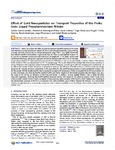Effect of Gold Nanoparticles on Transport Properties of the Protic Ionic Liquid Propylammonium Nitrate

Use este enlace para citar
http://hdl.handle.net/2183/28790
A non ser que se indique outra cousa, a licenza do ítem descríbese como Atribución 4.0 Internacional
Coleccións
- Investigación (FCIE) [1240]
Metadatos
Mostrar o rexistro completo do ítemTítulo
Effect of Gold Nanoparticles on Transport Properties of the Protic Ionic Liquid Propylammonium NitrateAutor(es)
Data
2021-07-21Cita bibliográfica
García-Garabal, S.; Domínguez-Pérez, M.; Cabeza, O.; Arosa, Y.; Varela, L. M.; Fernández-López, C.; Pérez-Juste, J.; Pastoriza-Santos, I. Effect of Gold Nanoparticles on Transport Properties of the Protic Ionic Liquid Propylammonium Nitrate. J. Chem. Eng. Data 2021, 8, 3028.
Resumo
[Abstract] Here, we analyze the effect of gold-nanoparticle (AuNPs)-doping of the protic ionic liquid (IL) propyl ammonium nitrate (PAN) on some physical properties, such as density, viscosity, and ionic conductivity, in a broad temperature range. This IL was lightly doped with four different AuNPs (concentration of gold lower than 0.2 mM): Au nanospheres of about 15, 60, and 80 nm diameter and Au nanorods of about 40 nm length and 12 nm width. AuNPs were synthesized following a seed growth approach and further functionalized with O-[2-(3-mercapto propionylamino)ethyl] O′-methyl-poly(ethylene glycol) (m-PEG-SH) in order to provide stability to the IL medium. The stability of the AuNPs in PAN was characterized by UV–vis spectroscopy. The results obtained here indicate that their presence produces a strong influence on the measured transport properties of PAN, decreasing viscosity up to 25% and increasing ionic conductivity up to 10% for the smallest AuNPs. Moreover, as temperature increases, the influence of AuNPs produces a decrease in the percentage deviations for viscosity and ionic conductivity. In the case of density, the AuNP-doping produces a mainly unexpected increase only for the sample with the smallest AuNPs, that is practically constant with temperature. When we equalize the AuNP concentration for all sizes and shapes, it is observed that the smallest AuNPs give higher variations in the studied properties than the bigger ones; also, the shape of the rod has an influence on the measured results. In addition, we have applied Walden’s rule to relate the three measured magnitudes, observing that AuNP addition decreases ionicity with respect to the reference sample, which is even more when we added smaller AuNPs. Finally, we explain all data assuming cation solvation of the AuNPs, which creates a local breaking of the pseudolattice structure of the PAN. Comparison with other published data is difficult because the behavior of a nanoparticle solution strongly depends on its particular composition and no data are available, in our knowledge, of any similar mixture to those studied here.
Descrición
Financiado para publicación en acceso aberto: Universidade da Coruña/CISUG The Supporting Information is available free of charge at https://pubs.acs.org/doi/10.1021/acs.jced.1c00135
Versión do editor
Dereitos
Atribución 4.0 Internacional
ISSN
0021-9568
1520-5134
1520-5134






